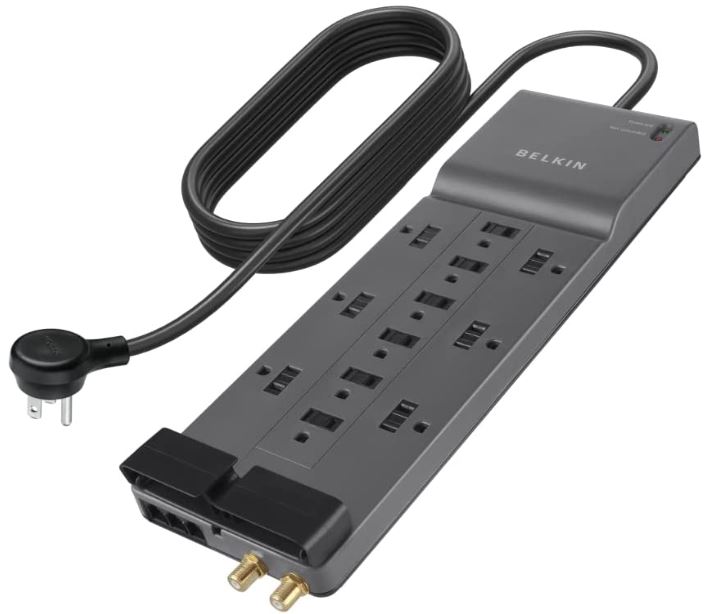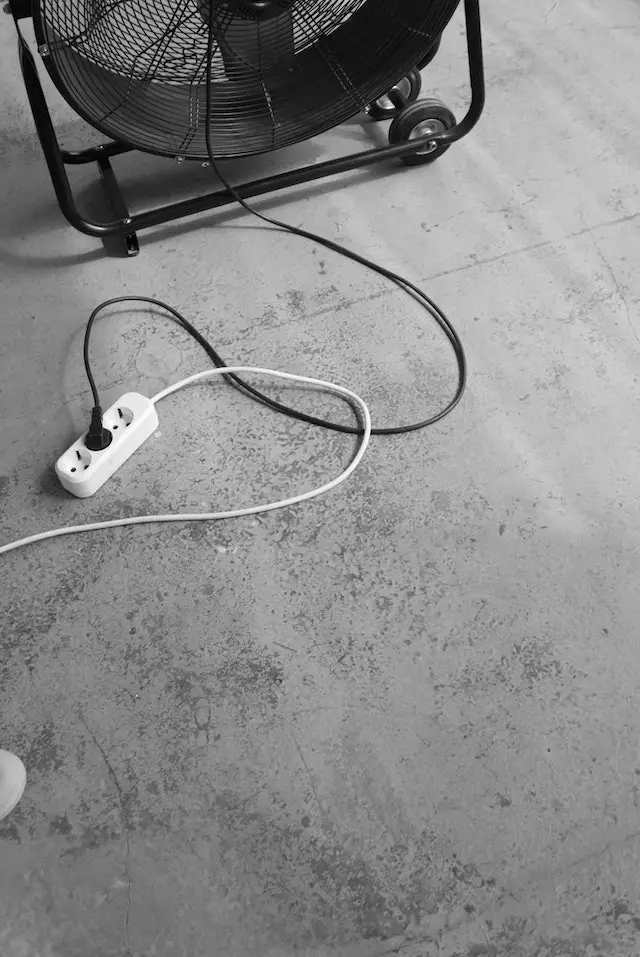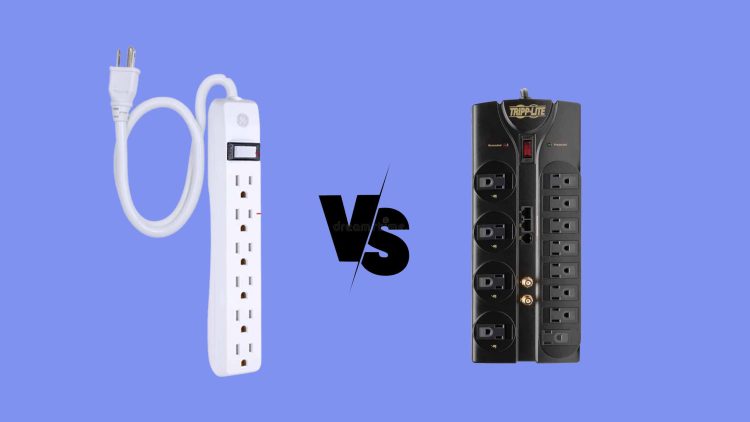Most people are confused between a surge protector and a power strip when shopping for extra electrical sockets. It’s because many of us don’t know the main difference between a surge protector and a power strip. So chances are that you may end up buying the wrong item. In this guide, we will split up things and make it easier for you to distinguish between these two electric components.
Surge Protector
A surge protector is a special type of electrical socket that keeps your electronic device safe from sudden power surges or lightning strikes. The mechanism inside a surge protector simply cuts down the excess power as soon as the spike is noticed in the circuit.
Every surge protector is equipped with MOV (metal oxide varistor) that absorbs the excess voltage while diverting excess voltage to the ground.
For example, you can use a surge protector for your gaming PC to prevent your expensive hardware from frying up.

Although a surge protector looks like a power strip, it has to do a bit more work as compared to a power strip. Just like a power strip, there are some extra power outlets on a surge protector to connect multiple devices at the same time.
What differentiates a surge protector from a power strip here is the type of power outlets it has to offer. Most surge protectors come with dedicated USB slots to charge your phone and other devices.
But when it comes to price, surge protectors are expensive compared to standard power strips. And the reason behind this is the complex circuit design of a surge protector which includes a controller, Latch or unlatch circuitry, and voltage sensor.
Pros of a Surge Protector
- Extended Life: Using a surge protector will extend the overall life span of your devices. Sudden power outages or electrical spikes can fry your whole device or some of its sensitive parts. So connecting your device to a surge protector socket will keep it safe from any spikes.
- Cost Effective: Surge protectors are a bit more expensive than power strips, but they still don’t break your bank account at all. Even top-quality surge protectors hardly cost more than $50.
- Reduced Maintenance Costs: A device protected via surge protector is less likely to fry up anywhere in the near future. This helps in reducing the maintenance cost to fix your device if you are not using a surge protector.
- High power absorption: Surge protectors come with higher energy absorption, some of which can even absorb as much as 2000 to 3000 Joules of energy.
Cons of a Surge Protector
- MOV Fades Out: With the passage of time and after bearing a number of power spike events, the MOV material used for absorbing the excess voltage becomes weaker. And this can later on result in the whole circuit being destroyed in the event of a massive voltage spike.
Power Strip
Power strips are everywhere in your home, school, and office. These are typically used for connecting multiple devices. You can connect the same type of devices on a power strip like you on a surge protector. However, there’s no MOV or voltage sensor in power strips to cut off power in case of surges or lightning strikes.

Power strips are more of an extension cord with a long cable. It gives you the convenience to connect multiple devices that are far from your main power outlet.
Compared to power surge protectors that can withstand a higher amount of power and heat, power strips have certain limits on them. For example, connecting an electrical device that consumes a lot of power can heat up the circuit.
Pros of a Power Strip
- Inexpensive: Power strips are much cheaper as compared to surge protectors. You can get one even under $10 or so.
- Longevity: Unlike surge protectors that have a limited life span, a power strip can last as long as 10 years before you throw it away.
- Convenience: Power strips provide a lot of conveniences when it comes to connecting multiple devices at the same time.
- Energy-Efficient: Power strips usually come with an on/off button to save energy. This puts less strain on your energy bills when you are not using any device.
Cons of a Power Strip
- No Surge Protection: Power strips cannot provide you any protection from voltage or power spikes as surge protectors do. There are higher chances of your equipment getting fired up in case of a lightning strike or power surge.
- Low Absorption: Power strips do not have the MOV material inside them that can absorb an extra amount of voltage coming from the wall outlet. So there are higher risks associated with a power strip. In general, the energy absorption capacity of a power strip is less than 500 Joules.
What’s the Real Difference Between Power Surge Protector and Power Strip?
Power strips are simply an extension platform that is equipped with multiple outlets to connect your computer, TV, modem, fridge, and other electronic equipment.
Though power strips are a convenient option, they do not guarantee any kind of protection to your equipment in case of voltage spikes or power outages.
As we’ve discussed earlier, the energy absorption capacity of a power strip is not more than 500 Joules.
A power surge protector is more like a power strip but with special protection circuit to keep your devices safe in case of sudden power surges or voltage spikes.
What a surge protector does is it absorbs the extra amount of power from the power outlet and redirects it to the ground instead of passing it over to your device.
It’s because the energy absorption capacity of a surge protector is as high as 2000 Joules. The higher the Joule routing, the higher would be the absorption capacity of a surge protector.
Which One You Should Choose, Surge Protector or Power Strip?
To be honest, there are more benefits that come along with a surge protector than a power strip. You really don’t want your expensive PC or TV getting fried as a result of a spiking voltage or power surge.
So, I’ll always recommend you spend a few more bucks on buying a surge protector to keep your devices safe from unwanted power surge events. Moreover, surge protectors are designed such that they can easily accommodate multiple devices with different plug shapes.
In the case of power strips, you’ll mostly end up with power outlets that are too close or too wide to firmly hold plugs in one position. Surge protectors on other hand come with different-shaped power outlets to install any device that you want. Moreover, there are fast USB charging ports on surge protectors to recharge your devices.

Hi, this is Masab, the Founder of PC Building Lab. I’m a PC enthusiast who loves to share the prior knowledge and experience that I have with computers. Well, troubleshooting computers is in my DNA, what else I could say….

